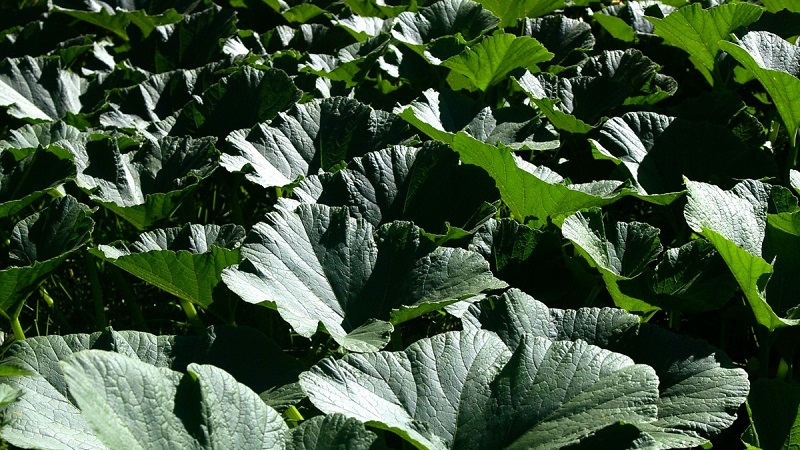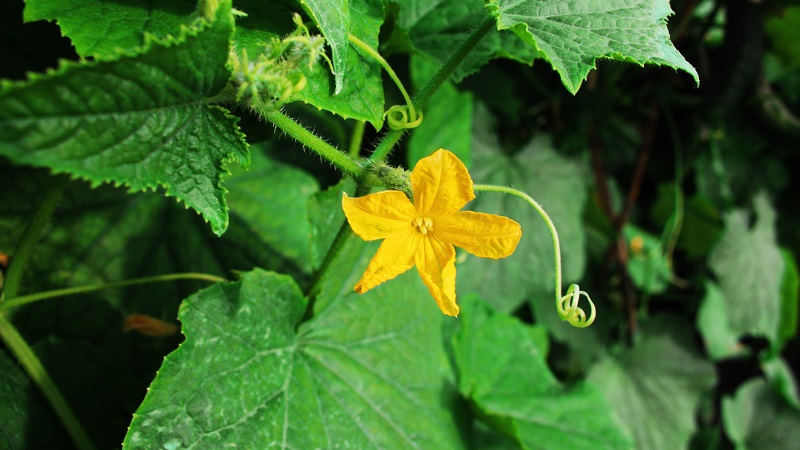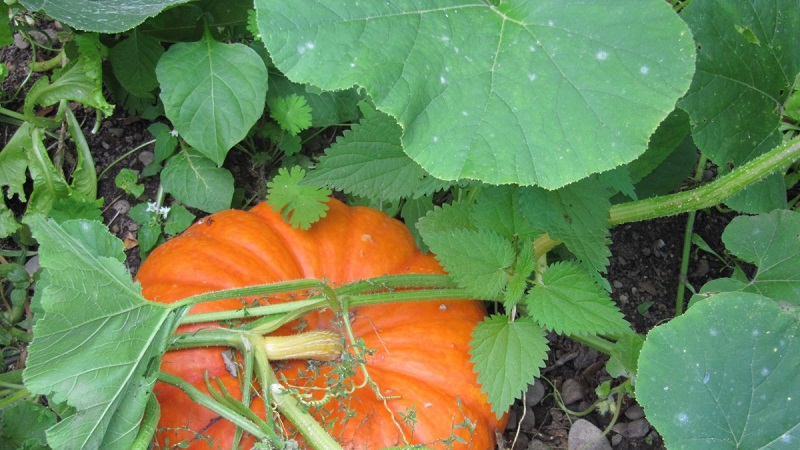Traditional methods of treatment with pumpkin leaves: how to use them in the fight against diseases
Benefit pulp and pumpkin seed is undeniable. Did you know that pumpkin leaves are just as useful? They are used both in cooking for cooking, and in folk medicine to treat pathologies of internal organs. In the article we will tell you about the beneficial properties and contraindications, the chemical composition and methods of using pumpkin tops.
The content of the article
Composition and useful properties of pumpkin leaves
In pumpkin, not only the pulp, peel, sunflower seedsbut also green tops. Its rich chemical composition has a beneficial effect on the human body and helps prevent the development of serious diseases.
Vitamins and minerals
The composition of pumpkin leaves includes:
- vitamins A, C, B1, B2, B5, B6, B9, PP;
- potassium;
- calcium;
- iron
- magnesium;
- sodium;
- manganese;
- copper;
- selenium;
- phosphorus;
- zinc.
Reference. There is more vitamin C in pumpkin tops than in pulp.
Beta-carotene has powerful effect on the human body: prevents the development of cancer, destroys viruses and bacteria.
Vitamin A normalizes vision, strengthens the skeletal system, tooth enamel, promotes rapid healing of skin lesions and deep wounds.
B vitamins prolong youth, tone up the body. They regulate the work of the central nervous system, relax the nerve channels. Substances are involved in metabolic processes, help to lose weight.
Vitamin C enhances immunity, synthesizes new cells, fights infections.
Vitamin E promotes responsible for the functioning of the gastrointestinal tract, improves the condition of hair and skin.
Folic acid indispensable during pregnancy - it is necessary for the development of the fetal neural tube.
Trace elements as part of pumpkin tops, they help fight diseases of the gastrointestinal tract, cardiovascular, endocrine systems. They normalize blood circulation, cleanse the body of toxic substances.
Organic acids normalize acid-base balance, digestion process, break down fat cells.
Fruit sugar - irreplaceable product for diabetics. Allows you to balance blood sugar levels.
Cellulose regulates the work of the digestive tract, improves intestinal peristalsis, helps to quickly remove toxins from the body.

KBZHU
The calorie content of pumpkin leaves is only 9 kcal per 100 grams.
Nutrients:
- fats - 0.40 g;
- proteins - 3.15;
- carbohydrates - 2.33 g.
The leaves contain 92.88 g of water and 1.24 g of ash.
Application in traditional medicine
Few people know about the medicinal properties of pumpkin leaves. Most often, seeds and pulp are used in recipes. In fact, the green part of melon has a lot of useful properties, and is used to treat the urogenital, endocrine, and immune systems.
Cancer treatment
Attention! Treatment of any cancer should be carried out exclusively under the supervision and with the approval of the oncologist. Uncontrolled use of "traditional medicine" can lead to irreversible consequences!
Pumpkin tops are also used in the treatment of cancer. Phenols, chlorophyll, flavonoids, tannins, saponins and glycosides are antioxidants that have a powerful impact on cancer cells.
The antitumor effect is achieved by binding and removing free radicals, slowing down oxidative processes.For treatment, decoctions and infusions are used, consumed raw and as part of salads.
Fight seizures
Compresses based on a decoction of pumpkin leaves relieve joint pain, eliminate cramps in the lower extremities, which develop as a result of stagnation of venous blood. For this, dry crushed leaves are poured with boiling water and infused for an hour. The proportions are arbitrary.
Increased fertility
Pumpkin leaves also help with the problem of childbirth. They are beneficial for both women and men.
Infusions and decoctions of pumpkin tops:
- normalize hormonal levels;
- stimulate the production of sperm;
- normalize ovarian function;
- prepare the eggs for fertilization.

Diabetes control
Decoctions of pumpkin leaves help control blood glucose levels for people with diabetes. Ethyl acetate and polysaccharides act as antidiabetic agents.
Since a metabolic disorder occurs against the background of diabetes, traditional healers are advised to take infusions from pumpkin leaves and flowers. To do this, take:
- 3 tbsp inflorescences and leaves of pumpkin;
- 3 tbsp licorice root;
- 2 tbsp rowan fruits;
- 2 tbsp. l. dried seaweed.
The components are crushed, mixed, folded into a jar and poured into 1 liter of boiling water. Insist for two hours, then filter and take ¼ glass several times a day.

Boosting immunity
Ascorbic acid helps to increase the body's defenses during the cold season. In order to prevent influenza and ARVI, it is recommended to take 200 ml of freshly squeezed leaf juice.
Skin and hair health
Pumpkin tops compresses help cure:
- acne;
- furunculosis;
- eczema;
- skin ulcers;
- seborrhea;
- burns.
Pumpkin tops juice strengthens hair, improves hair growth, moisturizes, makes it smooth and shiny. Use a meat grinder for cooking. Twist the leaves, squeeze out the juice and rub into the hair roots.

How to use pumpkin leaves
The pumpkin leaves have a soft texture and good taste. They are added to salads raw, stuffed, pickled, salted, pickled, soups are boiled, and used as a filling for closed pies. Decoction of pumpkin leaves - pleasant to the taste, smells like spinach.
Before adding the tops to the dish, it must be washed, sorted out, damaged and rough parts removed, and scalded with boiling water. Leaves are often used by vegetarians, adding them to cereals, bread dough, vegetable cutlets, cold soups.
How to store
Collecting pumpkin leaves for further storage begins in the summer. Most often, the upper tops of large-leaved breeds are cut. Before the frost hits, the remaining leaves are removed.
Drying the tops is not easy as it contains a lot of moisture. For this purpose, use the scorching rays of the sun, an oven or a gas stove. To store dry leaves, use linen bags, glass or plastic containers.
Pumpkin leaves are suitable for fermentation due to their high sugar content.
Contraindications
Pumpkin leaves have no contraindications and are well tolerated by the body. In rare cases, manifestations of an allergic reaction are possible. If melons are grown in ecologically clean conditions, have not been treated with chemicals, the tops can be used for food without fear. But pumpkin fruits and seeds are undesirable to use when stomach ulcer, diabetes and gastritis.

Conclusion
Pumpkin is a waste-free product. The pulp, green leaves, and flowers are also used for food. The benefits of tops are in a rich chemical composition and a healing effect. Fresh green shoots will be an excellent addition to dishes, infusions and decoctions will help improve the condition in diseases of internal organs.